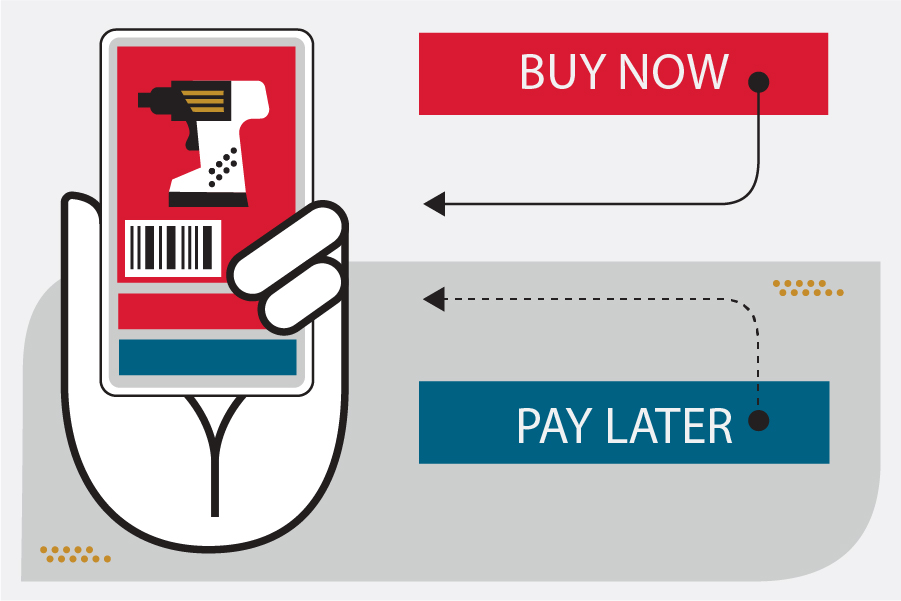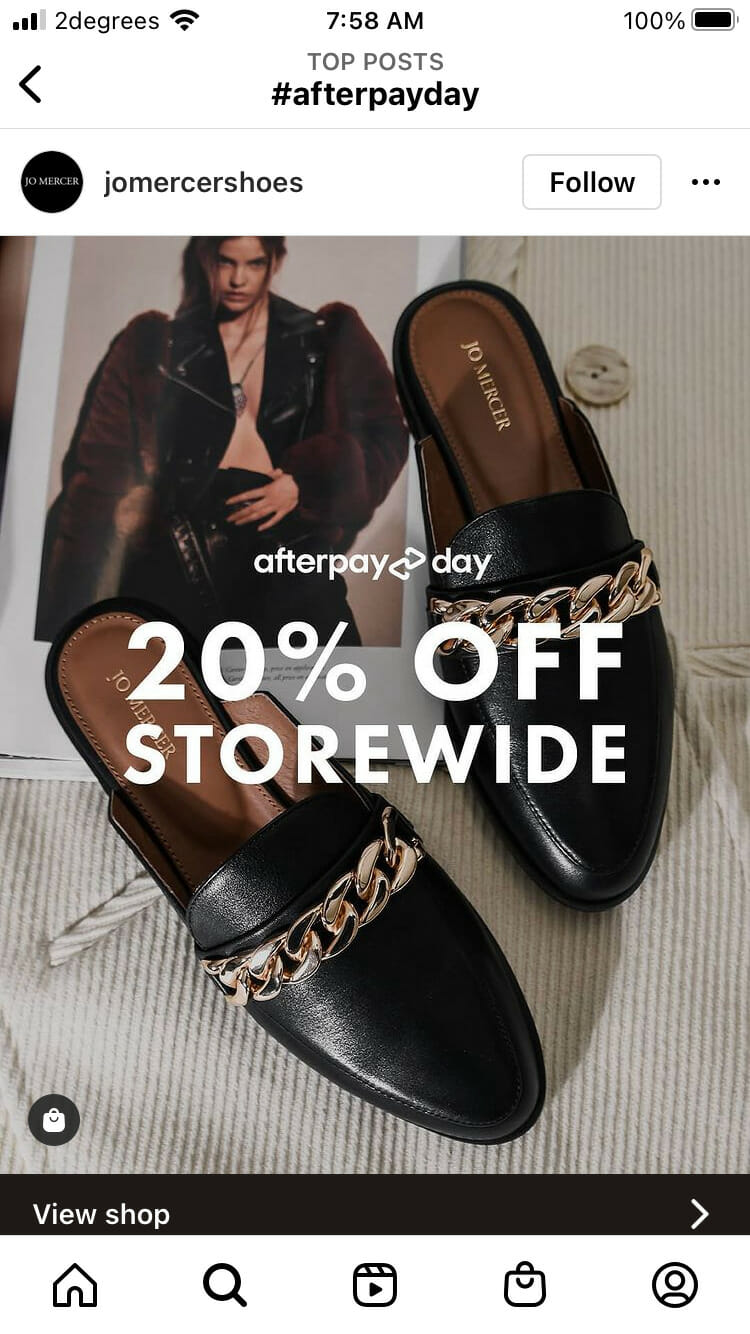Logistics
Industries
Technology & Innovations
E-commerce
E-commerce Fulfillment Services
Lease & Maintenance
Semi Trucks
Logistics
E-commerce
Lease & Maintenance
Buy Used Trucks

[Updated post from March 31, 2021]
Receiving a purchase before you pay for it sounds like a dream scenario in retail. Yet it’s fast becoming reality as a growing number of consumers take advantage of Buy Now, Pay Later (BNPL) plans.
It may sound too good to be true, but as deferred payment plans are normalized in online shopping and beyond, the brands who aren’t adding this service to their payment options are at risk of falling behind their competitors.
But what does BNPL financing look like, and what does your business have to consider when bringing a Buy Now, Pay Later plan to your customers?
‘Buy now, pay later’ (BNPL) is a deferred payment system where consumers can pay for a purchase at intervals over a fixed time period. Under this system, a customer will make an initial payment to receive items upfront (usually a percentage of the total sale) and then pay off the remaining balance via interest free installments.
In essence, BNPL is a personal loan where consumers must agree to make regular, on-time payments to the service provider, but without the red tape involved with traditional credit cards and banks.
Offering consumers payment plans to manage the cost of a purchase is not a new innovation. Traditional layaway systems have been used by department stores and independent retailers for decades, but with a couple of key differences. Firstly, consumers had to pay off the remaining balance before they were allowed to take their purchase home. Secondly, deferred payment schemes were much harder to access in the era before online shopping.
By combining the convenience of ecommerce with the near-instant gratification of getting items delivered before paying off the balance, Buy Now, Pay Later schemes have skyrocketed in popularity.
BNPL programs will set different rules concerning monthly installments, such as how much you can borrow and possible late fees or interest charges when payments are not made on time.
Some programs may require a soft credit check before you are allowed to start using the service. But unlike traditional credit cards, a BNPL provider is not required to report payments to credit bureaus.
Below is a typical outline of how Buy Now, Pay Later works when shopping online:
The purpose of Buy Now Pay Later is simple: to entice consumers to buy discretionary or high-value items that they might not commit to purchasing otherwise.
It’s easy to see why BNPL is so appealing to consumers. It keeps the upfront costs of shopping down while still getting to receive items upfront with no interest. In every sense, it's a win-win.
A report from Juniper Research estimates that the Buy Now, Pay Later market will reach $995 billion by 2026. Moreover, in a 2021 survey by C + R Research, 59% of respondents said they had used a BNPL service in the past year to purchase an unnecessary item they couldn’t afford to buy otherwise.
The vast majority of this growth comes from Gen Z and Millennial consumers, who are moving away from credit cards in favor of debit-based options. In the wake of the pandemic, 60% of millennials and Gen Z view credit cards as ‘too risky’, with BNPL presenting a much friendlier, more transparent alternative.
Yet there are also increasing signs that not all purchases made through BNPL are discretionary. A study by Credit Karma found that 53% of consumers who have used Buy Now, Pay Later have done so out of necessity, with 45% saying they’re most likely to use BNPL options when they're having cash flow issues.
So, why should merchants consider adopting a ‘buy now, pay later’ system for their store?
Consumer confidence is buoyed by only having to pay a small percentage of a purchase upfront when they shop online. This also means they are more likely to shop more often – and spend more money each time. According to a study by BNPL provider Affirm, retailers using its services saw an average increase of 20% in conversions and 87% in Average Order Value (AOV).
Moreover, one of the biggest advantages of offering BNPL loans is that brands receive the full value of the sale upfront, even though the customer is paying it off in installments. This means you don’t have to worry about cash flow or chasing up late payments – your third-party provider will do this on your behalf.
BNPL services are not just a payment system; they’re also a sophisticated way of curating brands.
As consumers grow accustomed to the advantages of Buy Now, Pay Later, they're more likely to begin searching for other retailers who offer this same service. This is a valuable marketing opportunity to appeal to new consumer segments - and even get featured by your BNPL partner.
Services like Affirm and Afterpay use their website and social media accounts to promote retail partners. Becoming a vendor will get you listed on the website’s directory, with further opportunities to get featured on specific category pages or social media feeds:

Hosting a BNPL service also gives you the opportunity to take part in network-wide promotions that attract both new and existing customers. For example, Afterpay’s 'Afterpay Day' initiative allows customers belonging to the AfterPay program to get exclusive discounts at participating retailers:

Some retailers have reported receiving as much as a 40% increase in sales after adding BNPL to their store – a clear sign that Buy Now, Pay Later has become a powerful marketing tool.
Buy Now, Pay Later enables customers to shop exactly how they please - even down the amount of money they pay upfront in that first payment. It's the definition of a flexible, customer-centric shopping journey that empowers customers to shop on their terms.
Regardless of whether they are pursuing big-ticket items or smaller purchases, BNPL makes stress-free online shopping accessible to consumers at all levels of spending power. It extends the value proposition of ecommerce in allowing shoppers to purchase whatever, whenever, using any smart device available to them. By offering this increasingly essential service, retailers can enhance brand loyalty and customer satisfaction.
However, Buy Now, Pay Later isn't without its fair share of fine print that merchants need to be aware of. While BNPL can be a useful tool for generating sales, there are some notable downsides:
While Buy Now, Pay Later does help retailers attract more customers, this does come at a price. Brands will be charged a percentage of the total transaction for using a BNPL provider. These fees can be as high as 6% - significantly more than traditional credit or debit card options.
If a customer chooses to return an item, they purchased using BNPL – a situation that affects as much as 40% of ecommerce sales – brands will not have this merchant fee refunded to them. This can seriously erode the product margins of BNPL sales, especially for smaller retailers who cannot rely on large sales volumes.
While adding more payment options gives customers more flexibility, it means there's a lot more for you to manage on the back-end. When you adopt any new technology platform, you’re faced with the often complex process of integrating it with your existing systems. While most third-party BNPL services do have native integrations with the major ecommerce platforms and payment processors, it’s your responsibility to troubleshoot any issues that occur.
BNPL programs do come with some ethical considerations, namely that they allow consumers to spend money they don't have.
Because Buy Now, Pay Later loans aren't governed in the same way as credit cards or other forms of personal finance, service providers only have to perform surface-level credit checks as part of the approval process. This means that some customers who regularly use BNPL are vulnerable to falling behind on payments.
In fact, more than 70% of consumers who’ve used Buy Now, Pay Later financing end up having interest charged. More worryingly, almost a third of shoppers say they didn’t know what the interest rate and fees would be before taking out a payment plan.
While this isn't a problem for merchants from the standpoint of late fees or missed payments, it raises questions over whether you want to encourage this behavior - and the possibility of some customers hurting their credit score if providers report late payments.
| Installment plan | Payment upfront | Late fees | Interest charges | |
| Klarna | Four installments or “pay in 30 days” | Variable |
$7, $35 for longer-term financing plans | 0%-30% |
| Afterpay | Four installments | 25% |
10% or 25% of the purchase value | 0% |
| Affirm | Four installments or monthly payments | Variable |
None |
0%-30% |
| Sezzle | Four installments | 25% | $10 | 0% |
Zip |
Four installments |
25% |
$7, (waived if paid within 10 days) |
0% ($1 fee with each payment) |
BNPL usage will only grow as consumers get used to it being available at their favorite retailers. But there's another reason that's motivating customers to turn to deferred payment plans: economic uncertainty.
Thanks to the pandemic and ongoing supply chain disruptions, many consumers are having to grapple with the Fear Of Missing Out on sought-after products, especially during peak periods like the holiday season. When combined with rising inflationary pressure on the economy, this is a perfect recipe for more reliance on BNPL.
Nearly one-fifth of consumers reported using a BNPL service to pay for all of their holiday gifts in 2021 – double the rate experienced in 2020. In sum, the merchants who embrace BNPL during these difficult conditions are giving themselves a strong competitive differentiator in a competitive marketplace.
The more mainstream that Buy Now, Pay Later becomes, the more that it's becoming integrated directly into the payment process itself.
The growth of embedded payment systems, where digital payment processing is integrated into the ecommerce shopping journey, is making BNPL even more seamless for customers. When the logo of their favored BNPL company is right there at the checkout, customers can log in and set up their monthly payments without even having to leave the brand's website.
Embedding BNPL deeply within the architecture of an app or website means that the customer is more aware of the product they’re purchasing - rather than how they're purchasing it.
Despite BNPL usage booming within online shopping, it remains a niche payment option within physical stores.
The February 2022 study 'BNPL and the in-store opportunity' discovered a massive divide between the availability of Buy Now, Pay Later between selling channels. While 51.9% of consumers purchasing from luxury brands online reported having BNPL financing options available to them, this shrinks to just 27.8% for in-store shoppers. A similar discrepancy can be seen at major retailers such as big-box stores, where 41.4% of online shoppers reported having access to BNPL, compared with only 12.2% of offline customers.
Moreover, 94% of consumers who have used BNPL in the past month say they would like to use deferred payment plans when shopping at a local store. This is hardly surprising; if a BNPL payment option is available when shopping online, it makes little sense to bar customers from accessing it when they shop in-store.
So, why has in-store Buy Now, Pay Later been slow to take off? The main barrier for retailers is that their POS system may not offer an integration with their chosen BNPL company. For example, despite acquiring Afterpay last year, Square is yet to create a native integration between the two systems. Unless merchants have the in-house ability to design an integration themselves, an omnichannel BNPL system remains off-limits.
As consumer expectations for BNPL grow, we can expect to see BNPL providers invest in more offline solutions. LayBuy, for example, now offers a digital card that consumers can store in their mobile wallet to set up a payment schedule in-store.
It’s a no-brainer why consumers want to see more of Buy Now Pay Later. But is bringing BNPL into your store a good growth strategy?
With consumer spending hard hit by the pandemic and increasing inflation, offering installment payments is a useful tool to help retailers to boost AOV. After two years of disrupted retailing, giving consumers more flexibility and choice over how they pay will give you a competitive edge.
However, high merchant fees could leave some brands worse off, especially those in high-return product categories like apparel and footwear. If your existing customers begin converting to BNPL en-masse, this could put a lot of pressure on your bottom line. And while it's easy to introduce Buy Now, Pay Later, it's much harder to remove it once your customers have gotten used to it being available.
Thanks to ongoing issues with consumers entering debt spirals due to Buy Now, Pay Later programs, several countries are examining whether BNPL providers require stronger oversight. It's possible that future changes could make the model less appealing to consumers or place a bigger burden on participating retailers.
As an emerging retail technology, it’s important that retailers keep a close eye on these ongoing developments in Buy Now, Pay Later to see how they can maximize the benefits while controlling its impact on their bottom line.